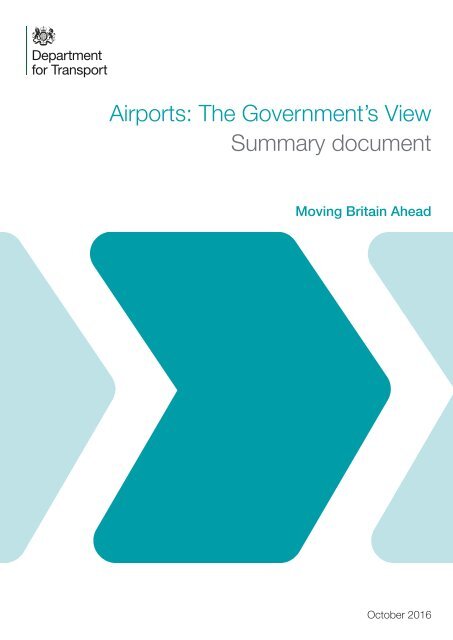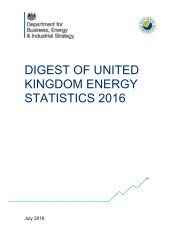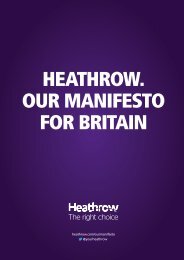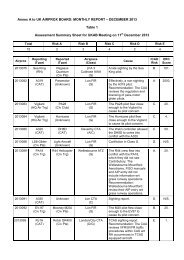Airports The Government’s View Summary document
heathrow-airport-expansion-summary-document
heathrow-airport-expansion-summary-document
Create successful ePaper yourself
Turn your PDF publications into a flip-book with our unique Google optimized e-Paper software.
<strong>Airports</strong>: <strong>The</strong> <strong>Government’s</strong> <strong>View</strong><br />
<strong>Summary</strong> <strong>document</strong><br />
Moving Britain Ahead<br />
October 2016
<strong>Airports</strong>: <strong>The</strong> <strong>Government’s</strong> <strong>View</strong><br />
<strong>Summary</strong> <strong>document</strong><br />
Moving Britain Ahead
<strong>The</strong> Department for Transport has actively considered the needs of blind and partially sighted<br />
people in accessing this <strong>document</strong>. <strong>The</strong> text will be made available in full on the Department’s<br />
website. <strong>The</strong> text may be freely downloaded and translated by individuals or organisations for<br />
conversion into other accessible formats. If you have other needs in this regard please<br />
contact the Department.<br />
Department for Transport<br />
Great Minster House<br />
33 Horseferry Road<br />
London SW1P 4DR<br />
Telephone 0300 330 3000<br />
General enquiries https://forms.dft.gov.uk<br />
Website www.gov.uk/dft<br />
© Crown copyright 2016<br />
Copyright in the typographical arrangement rests with the Crown.<br />
You may re-use this information (not including logos or third-party material) free of charge in<br />
any format or medium, under the terms of the Open Government Licence v3.0. To view this<br />
licence visit http://www.nationalarchives.gov.uk/doc/open-government-licence/version/3 or<br />
write to the Information Policy Team, <strong>The</strong> National Archives, Kew, London TW9 4DU, or<br />
e-mail: psi@nationalarchives.gsi.gov.uk.<br />
Where we have identified any third-party copyright information you will need to obtain<br />
permission from the copyright holders concerned.<br />
ISBN: 978-1-84864-184-6
Foreword<br />
International flights matter. <strong>The</strong>y support trade, inward investment and<br />
exports. <strong>The</strong>y create jobs and economic growth. And they give UK<br />
citizens the freedom to fly across the world – whether for business,<br />
leisure or to visit friends and family.<br />
But we face a capacity crunch. Over the last seventy years the UK has failed to build the<br />
capacity needed to match people’s growing desire for travel. While our international<br />
competitors have taken tough decisions to expand runway capacity, we have failed to build a<br />
new full-length runway in the South East since the 1940s. Today, Heathrow is the busiest two<br />
runway airport in the world and Gatwick the busiest single runway airport in the world.<br />
By 2040 every London airport will be full unless we take action.<br />
This Government is not afraid to take the big decisions. By supporting the construction of a<br />
new runway at Heathrow, we are sending a clear message to the world that Britain is open<br />
for business. It provides the greatest strategic and economic benefits for the UK, connecting<br />
our country with growing world markets including Asia and South America. It offers the best<br />
deal for passengers – increasing the choice of airlines and destinations while lowering fares.<br />
It is an investment that delivers the global connections the next generation needs.<br />
A new runway will also increase the number of UK airports connected to Heathrow and<br />
safeguard existing domestic routes. Heathrow is the UK’s biggest port by value, accounting<br />
for 30% of all non-EU trade, and its expansion will enable even more opportunities for UK<br />
businesses to reach new markets. Its location is well connected to the rest of the UK by<br />
resilient road and rail connections.<br />
This announcement follows the most comprehensive assessment of an infrastructure project<br />
ever undertaken in the UK. I am grateful to Sir Howard Davies and his <strong>Airports</strong> Commission<br />
for their work which has played a major part in supporting this process.<br />
However, I recognise the impact this announcement will have on those who live near the airport.<br />
That is why this proposal doesn’t just offer the greatest strategic and economic benefits but,<br />
also considers what is best for communities and the environment. As a result, up to £2.6 billion<br />
will be provided for noise mitigation and compensation. <strong>The</strong> new capacity comes with a six and<br />
a half hour ban on scheduled night flights for the first time. It also ensures the periods of respite<br />
from noise that are so valued by local communities which are overflown. A Northwest Runway<br />
can be delivered within air quality and climate change limits.<br />
Heathrow will continue to work with communities to deliver plans that are sensitive to local<br />
concerns. It is now for the government to consult on a draft National Policy Statement (NPS)<br />
in the New Year and seek further views before the issue returns to the House of Commons.<br />
<strong>The</strong> airport will then be free to submit its planning application. This is the quickest, simplest<br />
and fairest route to constructing a new runway.<br />
This is the right move for businesses, passengers and communities – for a country that works<br />
for everyone and invests in the next generation. Now is the time to move forward and seize<br />
this opportunity to show the world that Britain is open for business.<br />
Rt Hon Chris Grayling MP<br />
Secretary of State for Transport<br />
3
1. Why we need a new runway<br />
Aviation is a key driver to our economic prosperity<br />
Aviation creates jobs and supports economic growth. It directly supports around 230,000<br />
jobs with many more employed indirectly and contributes around £20bn annually to UK GDP.<br />
Heathrow alone directly employs more than 75,000 people, making it one of the biggest<br />
single site employers in the country.<br />
Aviation is even more important as an enabler of activity in the wider economy. It supports<br />
trade and investment. It supports the movement of goods, workers and tourists, and it drives<br />
business innovation and investment. In 2015, UK airports handled around £155 billion of air<br />
freight to and from countries outside the EU. Indeed, international companies say access to<br />
markets and the quality of transport links are key factors in global location decisions.<br />
Furthermore, aviation supports an inbound tourism industry across the UK worth nearly £19<br />
billion.<br />
Aviation gives people the freedom to fly abroad whether for business, leisure or to visit friends<br />
and family. Around half the UK population has travelled by air in the last twelve months.<br />
But we face a capacity crunch.<br />
<strong>The</strong> UK hasn’t built a new full-length runway in the South East since the 1940s.<br />
Today, Heathrow is the busiest two-runway airport in the world and Gatwick is the busiest<br />
single runway airport in the world. This makes it ever more difficult for airlines to operate<br />
efficiently. <strong>The</strong> result is more delays, higher fares and reduced global connectivity.<br />
By 2040 every London airport will be at full capacity unless we take action. This is true for<br />
every future scenario the Commission considered, with demand by 2050 significantly<br />
outstripping all available capacity, even when keeping aviation carbon emissions at 2005<br />
levels.<br />
Without action the UK will fall behind<br />
<strong>The</strong> UK’s European and global competitors have built new runways. While the UK’s hub at<br />
Heathrow is full, hub airports at Paris, Frankfurt and Amsterdam have spare capacity and are<br />
able to attract new flights to growth markets like China and South America. <strong>The</strong>se<br />
competitors have benefited from the constraints at Heathrow and seen faster growth over the<br />
past few years.<br />
<strong>The</strong>re is also growing competition from hubs in the Middle East including from hubs in Dubai,<br />
Abu Dhabi, Qatar and Istanbul. Heathrow lost its position as the world’s busiest airport in<br />
terms of international passenger numbers to Dubai in 2015.<br />
Ensuring that the UK maintains its competitive advantage in international connectivity is<br />
crucial to our economic well-being.<br />
4
Aviation directly supports around<br />
230,000 jobs<br />
with many more employed indirectly<br />
Aviation contributes around<br />
£20bn annually<br />
to UK GDP<br />
Heathrow alone directly employs<br />
more than<br />
75,000 people,<br />
making it one of the biggest single site employers<br />
in the country<br />
In 2015, UK airports handled around<br />
£155bn of air freight<br />
to/from countries outside the EU<br />
Aviation supports an inbound tourism industry across<br />
the UK worth nearly<br />
Million Passengers<br />
80<br />
70<br />
60<br />
50<br />
40<br />
2015 figures:<br />
Dubai (78m)<br />
Heathrow (75m)<br />
Paris CDG (66m)<br />
Istanbul (61m)<br />
Frankfurt (61m)<br />
Amsterdam (58m)<br />
30<br />
2010<br />
2011<br />
2012<br />
2013<br />
2014<br />
2015<br />
EU Hubs<br />
Selected non-EU Hubs<br />
Figure 1.2: <strong>The</strong> UK has been facing increasing competition from international hub airports in recent years.<br />
5
2. <strong>The</strong> <strong>Airports</strong> Commission<br />
<strong>Airports</strong> capacity is an issue that successive governments have found difficult to resolve. That<br />
is why in the autumn of 2012 the coalition government established the <strong>Airports</strong> Commission.<br />
<strong>The</strong> Commission was set up as an independent body with a brief to identify and recommend<br />
options to maintain the UK’s position as Europe’s most important aviation hub. It was led by<br />
Sir Howard Davies and its other members were Sir John Armitt, Professor Ricky Burdett,<br />
Vivienne Cox, and Professor Dame Julia King.<br />
<strong>The</strong> Commission published seven discussion papers, an appraisal framework, an interim<br />
report and a final report. It held more than 150 meetings including a number of public<br />
evidence sessions. It visited airports in the UK and abroad, airframe and engine<br />
manufacturers, transport providers, and the local areas affected by possible expansion.<br />
It published three separate calls for evidence and consulted on the detailed assessments of<br />
its three shortlisted options and an option for a new airport in the inner Thames Estuary.<br />
<strong>The</strong> Commission’s work is one of the most comprehensive assessments of any infrastructure<br />
project ever undertaken in the UK.<br />
Since the Commission published its final report, the Department for Transport has undertaken<br />
further work to produce additional evidence, including:<br />
●●<br />
●●<br />
●●<br />
Securing the best possible package on mitigations, such as noise, property<br />
compensation, air quality and jobs and apprenticeships<br />
Sensitivity testing the Commission’s air quality work<br />
Further assurance of the Commission’s wider and local economics analysis<br />
6
<strong>Airports</strong>: <strong>The</strong> <strong>Government’s</strong> <strong>View</strong><br />
Figure 2.1: Heathrow Airport Northwest Runway scheme map<br />
7
3. Why we have chosen a Northwest<br />
Runway at Heathrow<br />
It delivers the greatest economic benefits<br />
A new runway at Heathrow will provide the greatest economic and employment benefits,<br />
delivering between 38,000 and 77,000 additional local jobs by 2030 and up to £61bn of<br />
economic benefits – not including wider trade benefits. Analysis by the Commission found<br />
that most of the economic boost to GDP created by expansion would be felt outside the<br />
South East of England. Additional capacity will support growth in sectors that are particularly<br />
dependent on aviation such as tourism, financial services, creative industries, insurance,<br />
professional services, engineering, and pharmaceuticals.<br />
It provides the global connections the UK needs to stay competitive<br />
Heathrow is uniquely well-positioned to deliver the new long-haul flights the country needs to<br />
secure its position in the global economy. Expansion will increase the number of services on<br />
existing routes and allow airlines to offer new routes to emerging markets. Heathrow currently<br />
operates around 70% of the UK’s long-haul flights. A new runway is expected to deliver<br />
16 million additional long-haul seats by 2040.<br />
It provides better domestic connections for passengers<br />
<strong>The</strong> Commission forecasts that the new runway will double the number of domestic<br />
passengers travelling via Heathrow by 2030. It will support new domestic connections as well<br />
as safeguarding existing domestic routes. Heathrow has proposed a further six new routes to<br />
Belfast International, Liverpool, Newquay, Humberside, Prestwick and Durham Tees Valley to<br />
be added after expansion. This would provide 14 domestic routes in total, and spread<br />
benefits right across the country. A new runway could also provide a greater choice of airlines<br />
on existing routes and reduce fares on routes such as Edinburgh, Glasgow, Aberdeen,<br />
Inverness and Belfast City.<br />
It reduces fares for passengers<br />
Air fares are likely to be higher if runway capacity at Heathrow is not expanded. This is<br />
because demand for flights outstrips supply at Heathrow which results in higher fares for<br />
passengers. A new runway would bring in new capacity to meet demand and allow greater<br />
levels of competition, lowering fares even after taking into account the costs of construction.<br />
It delivers the greatest support for freight<br />
<strong>The</strong> plans for a new runway include a doubling of freight capacity at the airport. Heathrow<br />
already handles more freight by value than all other UK airports combined and twice as much<br />
as our two largest container ports – Southampton and Felixstowe. It is a vital freight route for<br />
industries from across the UK. For example, Heathrow’s biggest export by tonnage in 2014<br />
was fresh and chilled salmon, most of which came from Scotland.<br />
It is better connected to the rest of the UK by road and rail<br />
Heathrow Airport already has good road links via the M25, M4, M40 and M3, and rail links<br />
via the Piccadilly Line, Heathrow Connect and Heathrow Express. In future it will be<br />
connected to Crossrail, and linked to HS2 at Old Oak Common. Journey times to the airport<br />
8
<strong>Airports</strong>: <strong>The</strong> <strong>Government’s</strong> <strong>View</strong><br />
will be 53 minutes from Birmingham, 1 hour 23 mins from Manchester, and 1 hour 38 mins<br />
from Leeds. Western Rail Access could link the airport to the Great Western Main Line, and<br />
Southern Rail Access could link the airport to the South West Trains network and Waterloo.<br />
<strong>The</strong> planned upgrade to the Piccadilly Line will increase its capacity by 60% with new trains<br />
and new signalling. <strong>The</strong> large choice of road and rail connections makes it more accessible to<br />
the UK and resilient to disruption.<br />
Key economic benefits<br />
260k<br />
additional<br />
flights from<br />
Heathrow a year<br />
16m<br />
more UK long<br />
haul seats<br />
in 2040<br />
6<br />
new domestic<br />
UK routes<br />
by 2030<br />
Between<br />
38,000 and 77,000<br />
additional local jobs by 2030<br />
120<br />
100<br />
80<br />
£ Billion<br />
60<br />
40<br />
20<br />
0<br />
Heathrow Stansted East Midlands Manchester Gatwick Southampton Felixstowe<br />
Air ports<br />
Sea ports<br />
Figure 3.1: Heathrow freight by value compared to other ports in 2015<br />
9
4. How we will protect local communities<br />
and the environment<br />
This scheme has a significant focus on communities and the environment, including plans for<br />
up to £2.6 billion of noise mitigation and community compensation. This would give Heathrow<br />
a world class package of measures for environmental and community mitigation.<br />
It is tough on noise<br />
<strong>The</strong>re will be a ban on scheduled night flights of six and a half hours for the first time. This<br />
provides an extra hour and a half free from noise compared to today’s operation. <strong>The</strong> new<br />
scheme also provides predictable periods of respite from aircraft noise for every community<br />
overflown during the day. By the time a new runway opens, there will be many more quieter,<br />
next-generation aircraft in service such as the Boeing 787 and Airbus A320NEO. <strong>The</strong> location<br />
of the runway also allows aircraft to fly higher over central London and the airport is trialling<br />
the use of steeper descents to reduce noise.<br />
It is better on noise insulation for homes<br />
<strong>The</strong> airport has allocated over £700m to noise insulation. More than 160,000 homes from<br />
Richmond to Windsor could be eligible for some form of noise insulation compared to around<br />
40,000 today.<br />
It is generous on community compensation<br />
Those people whose properties will need to be bought to make way for the new runway will<br />
receive 125% of the un-blighted market value of their homes, plus stamp duty, legal fees, and<br />
moving costs. A further 3,750 homeowners in villages not subject to compulsory purchase<br />
but close to the new development will be entitled to this offer if they want to take advantage<br />
of it.<br />
It is deliverable within air quality limits and carbon targets<br />
<strong>The</strong> further work undertaken by the government since December confirms that a Northwest<br />
Runway at Heathrow can be delivered within air quality requirements.<br />
<strong>The</strong> Department for Transport has also set up a working group with HM Treasury and the<br />
Department for the Environment Food and Rural Affairs on air quality. This is the start of a<br />
10-year project which is expected to make significant progress on driving improvements in<br />
air quality<br />
<strong>The</strong> government also agrees with the Commission’s assessment, arrived at after engagement<br />
with the Committee on Climate Change, that an additional runway can be delivered within the<br />
UK’s climate change commitments. Heathrow has pledged that there will be no increase in<br />
airport-related road traffic with expansion and committed to a target of more than half of<br />
passengers using public transport to access the airport. Construction will use low-carbon<br />
and locally-sourced materials.<br />
10
Index 1990=100<br />
140<br />
120<br />
100<br />
80<br />
60<br />
40<br />
20<br />
0<br />
1990 1993 1996 1999 2002 2005 2008 2011 2014<br />
PM10 PM2.5 Nitrogen oxides Sulphur dioxide Lead<br />
Figure 4.1: UK’s improving air quality picture<br />
Aircraft<br />
type<br />
Population within<br />
60dBA<br />
Households within<br />
60dBA<br />
Airbus A340-600<br />
Boeing B787-9<br />
% Drop<br />
653,100<br />
350,600<br />
-46%<br />
274,800<br />
147,000<br />
-47%<br />
Figure 4.2: Comparison of the population and households affected by noise of older Airbus A340 with newer Boeing B787-9<br />
(Dreamliner) on typical westerly arrivals at Heathrow.<br />
This shows the 60 dBA Lmax noise footprint populations of the labelled aircraft, the level from an individual noise event that<br />
the WHO recommends should be avoided during the night. <strong>The</strong>se figures relate to a specific aircraft on a single flight, in<br />
contrast to the Lden metric, which is a weighted average of all types of aircraft over a 24 hour period. Lden is commonly<br />
reported at 55 dB, whereas plotting Lmax at this level would be unreliable and offer little insight.<br />
11
5. Next steps<br />
Steps to planning permission<br />
In the New Year, the government will bring forward a draft National Policy Statement (NPS) for<br />
consultation. An NPS sets out the planning policy which applications for nationally significant<br />
infrastructure projects must comply with in order to get planning consent. <strong>The</strong> process is<br />
designed to be as quick as possible without compromising fairness.<br />
<strong>The</strong>re will be an opportunity for all those with an interest in the scheme to express their<br />
views and for any new evidence to be presented to government. <strong>The</strong>re will be further<br />
Parliamentary scrutiny and there will be a vote in the House of Commons before it becomes<br />
national policy. If that policy is adopted, the airport operator can then submit a detailed<br />
planning application, confident that the high-level arguments are settled and won’t be reopened<br />
by the planning inspector.<br />
<strong>The</strong> airport will also need to start its own detailed consultations with local communities,<br />
airlines and passengers on the design of the project. <strong>The</strong> detailed design of Heathrow’s<br />
Northwest Runway project can and will change in response to consultation.<br />
Putting commitments on a legal basis<br />
Communities will want to ensure that Heathrow is held to the promises it has made.<br />
<strong>The</strong>re are a number of commitments that have been made by the airport operator that could<br />
become planning obligations, such as a ban on scheduled night flights and compliance with<br />
noise targets.<br />
Costs<br />
<strong>The</strong> costs of the scheme will largely be met by the private sector, but it is important that<br />
expansion comes at a price that airlines and passengers can afford while at the same time<br />
attracting the private investment necessary to finance the scheme. <strong>The</strong> government is<br />
sympathetic to concerns raised by airlines about the cost of the Northwest Runway scheme<br />
and expects the airport to reduce costs including by phasing the introduction of new<br />
infrastructure. <strong>The</strong> government will ask the Civil Aviation Authority (CAA) to work with airlines<br />
and the airport to agree the final design and costs. <strong>The</strong> CAA’s primary duty will be to protect<br />
the interests of passengers.<br />
Airspace<br />
In time a new runway will also require the redesign of the airport’s flightpaths. This will form<br />
part of a wider programme of airspace modernisation which is already needed across the<br />
country in the coming years. <strong>The</strong> Government expects to consult in the New Year on a range<br />
of national proposals covering noise and airspace. This will include whether there is a role for<br />
a new independent aviation noise body as the <strong>Airports</strong> Commission recommended.<br />
12
Early 2017<br />
Draft <strong>Airports</strong> National Policy Statement<br />
(NPS) published<br />
<strong>The</strong> NPS will set out the <strong>Government’s</strong><br />
position for developing a new runway by<br />
2030.<br />
Spring – Summer 2017<br />
Select Committee Scrutiny of Draft NPS<br />
<strong>The</strong> opportunity for parliamentary scrutiny<br />
of the draft NPS by the appointed Select<br />
Committee.<br />
Early 2017<br />
Start of national and local consultation<br />
on contents of draft NPS<br />
This will include a series of local and regional<br />
events around the country and in the vicinity<br />
of the selected airport. Expected to last for<br />
16 weeks until Spring 2017.<br />
Summer – Autumn 2017<br />
Analysis and review of responses<br />
& revision of NPS<br />
Full analysis of all responses received during<br />
the public consultation and associated<br />
events. Government reviews responses to the<br />
consultation and final report from the Select<br />
Committee and the NPS is revised to take<br />
these into account.<br />
Late 2017/early 2018<br />
Publication of final <strong>Airports</strong> National<br />
Policy Statement<br />
Government publishes final NPS in Parliament,<br />
with a subsequent debate followed by a vote.<br />
Late 2017/early 2018<br />
Designation of National Policy Statement<br />
Assuming the final NPS passes the<br />
parliamentary vote, it can be designated by<br />
the Transport Secretary.<br />
2018 – 2021/22<br />
Promoter takes forward scheme<br />
Once the National Policy Statement has been<br />
designated, Heathrow is able to begin the<br />
formal process of seeking planning permission,<br />
which includes further consultation with local<br />
communities.<br />
2025 – late 2020’s<br />
New runway operational<br />
Assuming the planning and construction process<br />
runs in line with the timetable set out by Heathrow,<br />
the new runway is expected to be operational<br />
between 2025 and late 2020’s.<br />
13







